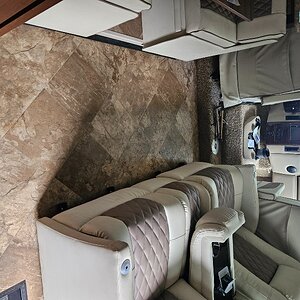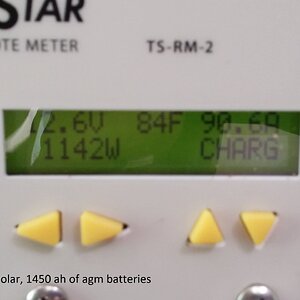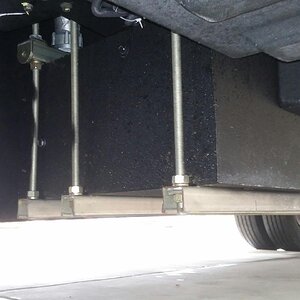Navigation
Install the app
How to install the app on iOS
Follow along with the video below to see how to install our site as a web app on your home screen.
Note: This feature may not be available in some browsers.
More options
Style variation
Welcome to RVForums.com
- Register now and join the discussion
- Friendliest RV Community on the web
- Modern site for PC's, Phones, Tablets - no 3rd party apps required
- Ask questions, help others, review campgrounds
- Get the most out of the RV Lifestyle
- Invite everyone to RVForums.com and let's have fun
- Commercial/Vendors welcome
You are using an out of date browser. It may not display this or other websites correctly.
You should upgrade or use an alternative browser.
You should upgrade or use an alternative browser.
Inverter
- Thread starter Rmcruiser
- Start date
Gronk
RVF Expert
- Joined
- Nov 13, 2019
- Messages
- 894
- Location
- Where ever I park it
- RV Year
- 2017
- RV Make
- Salem
- RV Model
- Hemisphere 346RK
- RV Length
- 38'
Bob K4TAX
RVF Expert
- Joined
- Mar 13, 2021
- Messages
- 613
- Location
- Tennessee
- RV Year
- 2016
- RV Make
- Forest River
- RV Model
- Wildwood XL 253 RLXL
- RV Length
- 25 ft or so
- TOW/TOAD
- Chev 2011 Silverado Crew Cab LTZ
- Fulltimer
- No
One needs to understand power management. Switch to LED lighting, and use propane for the water heater and refrigerator. So what type of equipment do you plan to use with the outlets? TV - not much power, hair dryer - lots of power, microwave - a LOT of power, Air Conditioning - a LOT of power, Coffee maker - lots of power, recharge cell phones or laptop computer - not much power.
Each piece of equipment lists the power required in watts. If it only gives amps, then multiply amps times 120 volts to get power in watts. Add all of the watts together to figure out the total needs in watts Of course, this assumes one tries to run everything at once. That is insane and an unreasonable expectation. Once you have the total watts, divide by 12 to get the number of amps from the 12-volt batteries. Multiply that by the number of hours you intend to run the item or items and that gives amp-hours. This is the required battery capacity needed in amp-hours. For normal flooded batteries or deep cycle, figure 50% discharge which means you'll need twice the amp-hours required from the batteries as one can safely only use 50% of the battery capacity without damage to the batteries. The converter size in watts should be equal to the largest load, plus about 10% minimum.
Each piece of equipment lists the power required in watts. If it only gives amps, then multiply amps times 120 volts to get power in watts. Add all of the watts together to figure out the total needs in watts Of course, this assumes one tries to run everything at once. That is insane and an unreasonable expectation. Once you have the total watts, divide by 12 to get the number of amps from the 12-volt batteries. Multiply that by the number of hours you intend to run the item or items and that gives amp-hours. This is the required battery capacity needed in amp-hours. For normal flooded batteries or deep cycle, figure 50% discharge which means you'll need twice the amp-hours required from the batteries as one can safely only use 50% of the battery capacity without damage to the batteries. The converter size in watts should be equal to the largest load, plus about 10% minimum.
One needs to understand power management. Switch to LED lighting, and use propane for the water heater and refrigerator. So what type of equipment do you plan to use with the outlets? TV - not much power, hair dryer - lots of power, microwave - a LOT of power, Air Conditioning - a LOT of power, Coffee maker - lots of power, recharge cell phones or laptop computer - not much power.
Each piece of equipment lists the power required in watts. If it only gives amps, then multiply amps times 120 volts to get power in watts. Add all of the watts together to figure out the total needs in watts Of course, this assumes one tries to run everything at once. That is insane and an unreasonable expectation. Once you have the total watts, divide by 12 to get the number of amps from the 12-volt batteries. Multiply that by the number of hours you intend to run the item or items and that gives amp-hours. This is the required battery capacity needed in amp-hours. For normal flooded batteries or deep cycle, figure 50% discharge which means you'll need twice the amp-hours required from the batteries as one can safely only use 50% of the battery capacity without damage to the batteries. The converter size in watts should be equal to the largest load, plus about 10% minimum.
Thanks for the explanation. Just want to run a CPAP machine, and would be nice to perk some coffee. Don’t the bigger units have outlets available for use? My point being, $30 k unit dry camping and can’t use outlets. Disappointing!!
- Joined
- Jan 19, 2021
- Messages
- 3,613
- Location
- Rosemary Farm
- RV Model
- Between RVs
- TOW/TOAD
- Toadless
- Fulltimer
- No
You’re actually better off. An inverter option would probably cost you more than you’ll spend doing it yourself and you’ll probably end up with better equipment. A lot of RV manufacturers that do include an include an inverter, either as standard or an option, use the cheapest junk from china and it usually only provides enough power for TV, lights, and charging phones. Like 600-1000w.
You want 2kw if your are going to make coffee while doing anything else that requires 120v. A factory system would just be more junk that you‘d rip out and upgrade. As an example my Newmar Bay Star had a 600w inverter. Great for TV I guess, but not near enough to make coffee. I ended up using it as a junction box. I used a 3kw Victron inverter but I was also running AC off a big Li-Ion battery bank. 2kw will run your coffee maker, toaster, and microwave, though one at a time. A hair dryer too if thats an interest.
So go forth and conquer and check back here for thoughts on possible equipment before you buy. For me it would be Magnum, Victron, or Outback ONLY, All three have different attributes/specialties, but you cant go wrong with any of them. They are of course also the most expensive but worth it because you only have to buy once. Get what you pay for and all that.
Bob, thanks for an excellent explanation of power management - better than I could have said it!
You want 2kw if your are going to make coffee while doing anything else that requires 120v. A factory system would just be more junk that you‘d rip out and upgrade. As an example my Newmar Bay Star had a 600w inverter. Great for TV I guess, but not near enough to make coffee. I ended up using it as a junction box. I used a 3kw Victron inverter but I was also running AC off a big Li-Ion battery bank. 2kw will run your coffee maker, toaster, and microwave, though one at a time. A hair dryer too if thats an interest.
So go forth and conquer and check back here for thoughts on possible equipment before you buy. For me it would be Magnum, Victron, or Outback ONLY, All three have different attributes/specialties, but you cant go wrong with any of them. They are of course also the most expensive but worth it because you only have to buy once. Get what you pay for and all that.
Bob, thanks for an excellent explanation of power management - better than I could have said it!
- Joined
- Jan 19, 2021
- Messages
- 3,613
- Location
- Rosemary Farm
- RV Model
- Between RVs
- TOW/TOAD
- Toadless
- Fulltimer
- No
Also whatever battery or batteries came with your trailer are not up to the task. 2 100ah AGMs would probably be enough and of course you need some way to charge them. If you dont want to use a generator, two 165w 12v panels to should replenish the batteries sufficiently given enough sun. But that also means parking the trailer in the sun so that may not be desirable.
Bob K4TAX
RVF Expert
- Joined
- Mar 13, 2021
- Messages
- 613
- Location
- Tennessee
- RV Year
- 2016
- RV Make
- Forest River
- RV Model
- Wildwood XL 253 RLXL
- RV Length
- 25 ft or so
- TOW/TOAD
- Chev 2011 Silverado Crew Cab LTZ
- Fulltimer
- No
I installed a 2KW Pure Sine Wave inverter in our previous trailer. I also upped the battery capacity to use 2 100aH AGM batteries. That would easily run the CPAP machine overnight and still have enough juice in the batteries to perk coffee. But that was about it. I changed all lights to LED and ran the ref and water heater off of propane.
They do make 12 V CPAP machines. These might be more efficient.
The Champion model 200951 is a very good, quiet, and efficient generator for under $500. About what a good inverter and a set of batteries would cost. Of course, one can't run it at night but it certainly will charge batteries.
I read stories of folks spending 10X or more what you spent and have the same issue with outlets.
Bob
They do make 12 V CPAP machines. These might be more efficient.
The Champion model 200951 is a very good, quiet, and efficient generator for under $500. About what a good inverter and a set of batteries would cost. Of course, one can't run it at night but it certainly will charge batteries.
I read stories of folks spending 10X or more what you spent and have the same issue with outlets.
Bob
- Joined
- Jan 19, 2021
- Messages
- 3,613
- Location
- Rosemary Farm
- RV Model
- Between RVs
- TOW/TOAD
- Toadless
- Fulltimer
- No
THIS! I have a Phillips Dreamstation, and "found" a 12 volt power cord for it on Amazon. I did have to wire in a 12 volt port on my Jayco TT, (which has been replaced with a Coachmen 5er), and it works quite nicely. I also have a 2000w Harbor Freight modified sine inverter that is enough to run a residential, 120v Mr. Coffee machine. I usually fire up the (900w) generator for that, though, as I don't care for dragging my battery bank down that much. (BTW; A Mr. Coffee claims it needs 900w, and I can attest that my little generator does run it through a full cycle.) (Also, my generator is the earlier Coleman version of the Harbor Freight "Tailgator" generator. The green 2-cycle one.)They do make 12 V CPAP machines. These might be more efficient.
Bob
Roger
Bob K4TAX
RVF Expert
- Joined
- Mar 13, 2021
- Messages
- 613
- Location
- Tennessee
- RV Year
- 2016
- RV Make
- Forest River
- RV Model
- Wildwood XL 253 RLXL
- RV Length
- 25 ft or so
- TOW/TOAD
- Chev 2011 Silverado Crew Cab LTZ
- Fulltimer
- No
Folks need to understand that RV's will have limits to the amount of power one can expect to use. A 30-amp service will provide 3600 watts total. A 50-amp service will provide 12,000 watts total. To use an inverter, i.e. the box that converts 12 VDC to 120 VAC, one needs to anticipate how much power in watts will be needed to be supplied from the inverter.
The power for the inverter comes from the system batteries. A 2000-watt inverter at full load will pull about 200 amps from the battery system. And with no load, about 2.5 amps while idle. A typical wet cell battery can be safely discharged 50% so a 100 aH battery has about 50 aH of power available. One also must look at the maximum power/current that can be pulled at a given time from the battery.
If one expects to run the microwave expect about 700 to 1200 watts needed. The refrigerator on AC at about 250 watts. The water heater on electric about 1200 watts. A hairdryer is about 800 to 1200 watts.
I keep using the term "power management". That means just because one has the appliances and outlets installed is NO INDICATION they can be used simultaneously or used at all when on inverter power. Doesn't make any difference if it is a $10,000 unit or a $1,000,000 unit. There are limits and one needs to learn and understand how to utilize the power available according to the limits of the systems. I say systems plural because there is the 120-volt AC system, the 12-volt DC battery system, a generator system, and in many cases a solar system
Bob
The power for the inverter comes from the system batteries. A 2000-watt inverter at full load will pull about 200 amps from the battery system. And with no load, about 2.5 amps while idle. A typical wet cell battery can be safely discharged 50% so a 100 aH battery has about 50 aH of power available. One also must look at the maximum power/current that can be pulled at a given time from the battery.
If one expects to run the microwave expect about 700 to 1200 watts needed. The refrigerator on AC at about 250 watts. The water heater on electric about 1200 watts. A hairdryer is about 800 to 1200 watts.
I keep using the term "power management". That means just because one has the appliances and outlets installed is NO INDICATION they can be used simultaneously or used at all when on inverter power. Doesn't make any difference if it is a $10,000 unit or a $1,000,000 unit. There are limits and one needs to learn and understand how to utilize the power available according to the limits of the systems. I say systems plural because there is the 120-volt AC system, the 12-volt DC battery system, a generator system, and in many cases a solar system
Bob
Similar threads
- Replies
- 1
- Views
- 715
Latest resources
-
-
Trueline Leveling System (Valid Air)Operation & Service Manuals for the Valid Air leveling system
- Jim
- Updated:
-
-
Notes on the Electrical Systems of the Roadtrek Zion Family of RVsNotes on the Electrical Systems of the Roadtrek Zion Family of RVs
- dilbertjth
- Updated:
-












